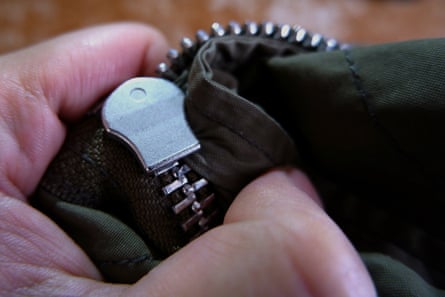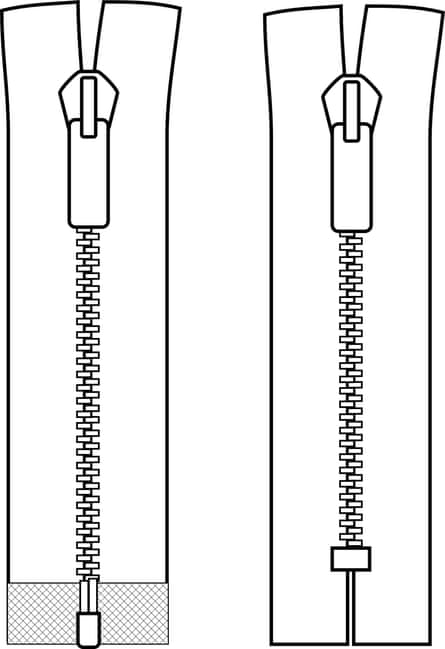
The zipper might be the most underappreciated of all the gadgets we use every day. Without it our trousers, jackets, suitcases and wallets wouldn’t close. And I have to admit, until writing this article I’d never stopped to consider how a zipper really works. Now I know how simple it is, it’s kind of thrilling.
The two sides of a zip have to be positioned so the tiny metal teeth slip in-between the teeth of the opposing side. One side’s teeth are slightly hollowed and the other slightly hooked, so when they slide together they fasten. The magic happens inside the slider: an internal wedge angles the teeth together as it does up, and the narrow end separates them as it slides back down.
Zips mostly get into trouble when the teeth are bent out of shape or slip out of alignment, which can render the whole object unusable. Here, experts explain how to resolve the problem.
Take the pressure off
Zippers are most commonly damaged when they’ve been forced by hand, says the fashion designer and sustainability lecturer Meg Parry.
A zipper that’s been forced has been asked to do too much of the work it takes to close something up. One way to prevent damage is to make sure the sides of the garment or bag you’re zipping are close together before you do it up, either with your hands or a closure.
“All zippers that are under any sort of tension should have a hook and eye, or button fastening at the top of the zipper to take the tension off before it is done up,” says Zoe Gymer-Waldron, a teacher at the School of Sewing and Upcycling. “This is why we have a button at the top of our jeans fly, and a hook and eye at the top of a zipper on a pencil skirt.”
Troubleshooting

Caught fabric: The simplest way to remove fabric that’s been caught in the teeth is to check the underside of the zip, this will give you a clear idea of what’s caused the issue. “Then you may be able to gently angle the slider back and pull the fabric out underneath the slider,” says Parry.
Pull the fabric in the opposite direction to the zip, but go slowly and carefully to avoid tearing the fabric or damaging the slider.
Zippers that stick: If your zipper is only closing halfway, this is usually because the teeth are bent, or have come out of alignment. To fix this, try pulling the slider back down and away from the spot that’s sticking. Then take some wax or soap, says George Chan, a garment technician at RMIT University, and rub it up and down along the problematic teeth to give the slider a smoother path.
If this doesn’t work, you might have to reach for some pliers to push the bent teeth back into shape. Take a pair of fine nose pliers and clamp them down on the teeth to squeeze them back into their original line.
“You can find any good pliers [at your] local hardware store,” says Parry. Look for “long nose and combination pliers, along with wire cutters, they are the best for working on zips”.
Zippers that slide open: Chan says zippers should lock into place when the teeth have closed and the pull tab on the slider is resting flat. When a zip is sliding open it’s because the mechanism in the teeth isn’t locking – this means the zip will need to be replaced.
If you are swapping a zip out, it’s worth upgrading to something more durable. “Some jeans zips have built-in spikes that press into the teeth to hold the slider in place at the top,” Parry says, adding “details like these are great if you’re replacing a jeans or trouser zip”.
after newsletter promotion
For a short-term fix Parry suggests fastening a keyring through the slider, closing the zip and looping the ring over the button (say on a pair of jeans or trousers) to hold it in place. For items that don’t have a button, she recommends fastening a safety pin under the slider at the top of the zip, which will stop it from coming down.
How to replace a zipper
There are a few occasions when the best course of action is to replace the zip entirely – including when the slider isn’t closing the zipper at all; if the two sides of the zip have become misaligned; if an open bubble has formed in the zip when it’s closed; or if the slider is only running along one side of the zip. There are some tricks that might save a zip in these scenarios, like pulling off the stopper, replacing the slider or removing some teeth, but these are all skills best learned in person.
If you’re game to try replacing a zip yourself and you’ve never done it before, it’s worth watching online tutorials first.

Photograph: Inga Linder/Alamy Stock Vector
“You’ll need to consider the fabric weight or the type of garment and the level of stitching details that need to be replicated to complete the finished area,” says Chan. “You also need to consider if the zip is an open-end zip, closed-end zip or an invisible zip.” Each type needs to be sewn into the garment in different ways, and invisible zips are notoriously fiddly.
If you’ve decided to move ahead you will need to “source a zip that is the same type, close colour match and a suitable length,” says Parry. This could be a straightforward “add to cart” or a frustrating goose chase through multiple fabric shops, depending on your specific needs.
Once you have found a good match, use a seam ripper to remove the original zipper from the garment, then pin your new zip into place.
“A zipper can easily be sewn in with a needle and thread and a decent sturdy half back stitch,” says Gymer-Waldron. If you’re capable on a sewing machine and want to use one, she says to be sure you use the zipper foot attachment.
Ultimately, don’t be scared to admit defeat, at any stage of the process. Chan says the important thing is to not “discard a garment when you think the zip is broken”.
“Always ask a professional as there is always a method to repair or replace the zip.”


